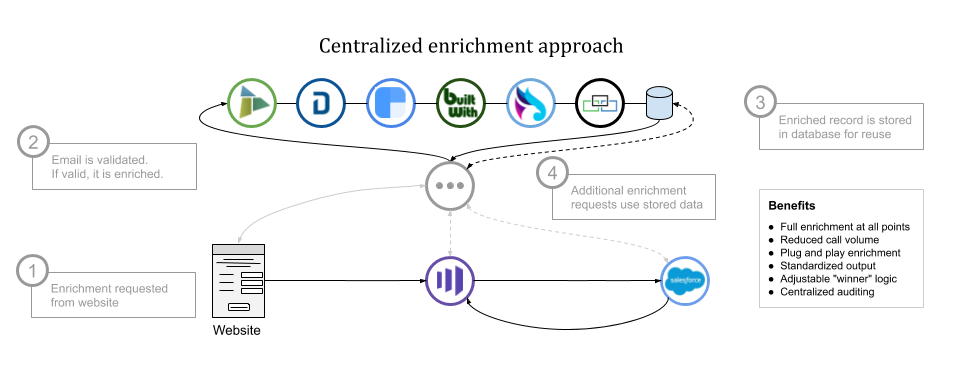(Part 1 of our series)
Most marketing organizations start with data enrichment innocently enough. “We just need some key data to shorten our forms for better conversion,” or “wouldn’t it be great if we could validate our company data for MQLs?” Now, it seems like every organization has some kind of enrichment technology embedded into each of the various applications and data stores that power it. Given the multiple vendors and distributed model, enrichment is sometimes seen as one of those Marketing technologies that’s valuable but difficult to quantify. When faced with budget-conscious marketers, data-hungry program managers, and technology-leary IT teams you need to be able to answer complicated questions about the ROI of your enrichment investment.
This multi-part blog series will explore how sorting out your data enrichment strategy could be the start of your MarTech 2.0 evolution.
The Basics
No matter how simplistic your data enrichment provider appears, remember you are working with BIG data. Just think about the number of activities and behaviors that enrichment vendors need to collect on millions of people and hundreds of thousands of organizations across the planet – many with multiple identities (e.g. emails, personas). And don’t even get me started on B2C intent data. I’m simultaneously creeped out and amazed. Nevertheless, these algorithms are necessary to fill gaps in your data to reach your marketing and conversion goals.
This data can be used to reduce form fields to increase conversions, verify valid business email addresses, and append data needed for segmentation, demographics, personalization, etc… Some popular players in the data enrichment space are ZoomInfo, DemandBase, Clearbit, Builtwith, DiscoverOrg, and RingLead for email validation.
This Sounds Great, What’s the Problem?
1. It can be expensive. Most companies need multiple data providers because their data sets vary in completeness, quality, coverage, etc. Some of these service providers are much better at providing firmographic data than they are providing personal data which is a completely different ballgame. Some services specialize in geolocation data and others in email verification and validation services. And still, others specialize in intent data. Getting a complete set of data (which is impossible in this game) to meet all of your marketing objectives would clearly require multiple services. Use cases going beyond marketing may require even more.
2. Each service needs to be integrated. To realize the benefits of enrichment, you’ll need to integrate these directly into specific applications, but because enrichment is happening in many places, your data will have to sync between all of your systems before having a complete picture of what you’ve enriched.

3. What data is coming from where? Since data is now being enriched everywhere you’ll have a hard time knowing which services are bringing the most value, which are providing the most complete and highest quality data, or even what data you have at your disposal before going out and adding another provider to the mix.
4. Did we mention it can be expensive? To add insult to injury, many of these services charge by volume, and direct integration with your applications without call optimization could lead to exorbitant costs. I’ve seen this easily add up to a $500,000 yearly expense with no understanding or quantifiable data on the return of this marketing investment.
Enter Centralized Enrichment
So, what’s the solution? You guessed it, centralized enrichment. Even if this isn’t implemented across the entire company, you should absolutely do this for the enrichment services to which marketing subscribes.
The concept is to combine your enrichment service providers to create a single master service that then calls those services, gets all of the data back, and stores it somewhere before responding back to the requesting system.

You’ll standardize the way you’re requesting enrichment. All of the applications that you have can benefit from the complete data set provided by all of your vendors – and that you’re already paying for. They all connect in the same way and the integration is as simple or sophisticated as you need it to be. Application owners at your organization don’t have to figure out how the API for each of these different enrichment vendors work and they don’t need to be concerned about which data is appropriate for use across the company – the central service is built with governance in mind.
All requests are written into a database along with a timestamp for when a contact was last enriched. Now, if data for that email address is requested within say 30 days of that timestamp, instead of calling out to the service providers again you can just pull it from your database. This reduces the volume of the calls that you need to make, reducing service costs.
With decentralized enrichment, data quality analysis is nearly impossible which makes it difficult to justify your enrichment spend to leadership. The data store enabled through centralized enrichment allows your Marketing Intelligence team to easily perform data quality, completeness, and coverage analysis to determine if you’re actually getting what you’re paying for. Sunset any vendors that aren’t achieving ROI and replace them with another data set that will see results.
Unlike Centralized Enrichment, sunsetting applications with a decentralized enrichment model require you to disconnect each application. With a Centralized Enrichment Service model, you can just replace it in your flow one time and every single application that is connected will be able to take advantage of it instantly without changing a thing and without disruption.
So we have covered the “why” on our love of Centralized Enrichment Service, read our next post, which will cover the “how” on building your own Centralized Enrichment Service.
Sign up now to get updates from Etumos or speak to one of our consultants with questions or find out how you can start your Central Data Enrichment Service today!







